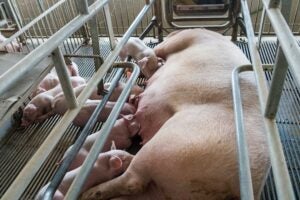Farrowing is the term for a sow (female pig) birthing a litter of piglets. A sow can weigh anywhere from 400 to 650 pounds, making them 300 times heavier than the piglet when it is born. As you can imagine, this could become unsafe for the piglets. But with something called farrowing stalls, farmers can keep the little ones safe and still allow them to get all nutrients needed from their mothers.
Today, large swine farms will have multiple farrow stalls in a climate-controlled barn. This allows the farmers to closely monitor the sow and piglets while keeping the concept of their natural birthing ways. Meaning, sows move themselves away from others a few days before they give birth, so farmers do the same thing. The main priority of farrowing stalls is to keep piglets safe and reduce their mortality rate.

These pens are built with adjustable rails to slow down the sow when she lies down, preventing her from smashing the piglets. Additionally, you can see the bars above where piglets can suckle on their mom but also have an escape route. These bars allow piglets to move to a safe space if the sow lies down — in an open pen, there’s a greater chance for the piglets to be smashed against a wall.
These stalls have other benefits as well. When born, piglets have a sudden reduction in body temperature. They normally recover to their normal temperature, 102.2°F (39°C), within the first 24 to 48 hours. Adding heat lamps and pads can help return the piglet back to its normal body temperature, increasing their chance of survival.
Farrowing stalls can also help keep handlers safe from aggressive sows. The floor is either concrete or a grate to make fecal matter easier to move instead of staying put, which could infect the new piglets.
Sows are comfortable in these stalls and it keeps their natural birthing process. To further ensure safety for the animal and human handlers, they stay in these stalls until the piglets are weaned at 4 to 8 weeks old. The breed of pig you have can make a difference in when you wean them, but there are a few things to look for when determining if it’s time to wean the piglets. If you place dry food in with the piglets, the transition can slowly start and be more natural for the piglets. By eating the dry food, this is a social cue to know if the piglets are ready to be weaned. Another social cue is when the piglet becomes more independent, not searching for their mother when it’s time to eat and will spend more time with their littermates.
Farmers use practices with their animals’ best interest in mind. Farrowing stalls allow the piglet to still get the needed nutrients without being crushed. There are many different options so a farmer can choose which works best for their operation. All have the same basic goal, keeping the piglets safe during their early days.
Michelle Miller, the “Farm Babe,” is an internationally recognized keynote speaker, writer, and social media influencer and travels full time to advocate for agriculture. She comes from an Iowa-based row crop and livestock farming background and now resides on a timber farm in North Central Florida.



